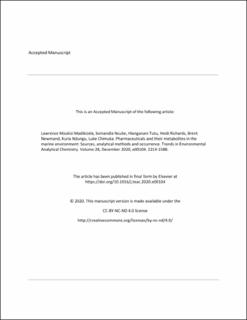| dc.contributor.author | Madikizela, Lawrence Mzukisi | |
| dc.contributor.author | Ncube, Somandla | |
| dc.contributor.author | Tutu, Hlanganani | |
| dc.contributor.author | Richards, Heidi | |
| dc.contributor.author | Newman, Brent | |
| dc.contributor.author | Ndungu, Kuria | |
| dc.contributor.author | Chimuka, Luke | |
| dc.date.accessioned | 2021-06-01T06:50:04Z | |
| dc.date.available | 2021-06-01T06:50:04Z | |
| dc.date.created | 2021-01-03T16:04:33Z | |
| dc.date.issued | 2020 | |
| dc.identifier.citation | Trends in Environmental Analytical Chemistry. 2020, 28, e00104. | en_US |
| dc.identifier.issn | 2214-1588 | |
| dc.identifier.uri | https://hdl.handle.net/11250/2757129 | |
| dc.description | This is an accepted manuscript version. Embargo until October 4 2021. | en_US |
| dc.description.abstract | The occurrence of pharmaceuticals in the environmental waters is a global concern. There is little research conducted on the monitoring of pharmaceuticals in the marine environment. In this article, the occurrence of pharmaceuticals and their metabolites in the coastal waters as well as associated risks related to their uptake by marine organisms are critically reviewed. The literature showed antibiotics as the most plentiful pharmaceuticals in the marine environment. Other therapeutic classes of pharmaceuticals appeared prominently in the marine environment are non-steroidal anti-inflammatory drugs and β-blockers, while gemfibrozil and carbamazepine were singled-out as the most studied lipid regulator and antiepileptic, respectively. Some pharmaceuticals have been found present in the marine organisms that are regarded as important food sources for humans. We reviewed the negative effects associated with the presence of pharmaceuticals in the marine environment. This article is concluded by deliberating on the possible future studies in this research niche area. | en_US |
| dc.language.iso | eng | en_US |
| dc.publisher | Elsevier | en_US |
| dc.rights | Attribution-NonCommercial-NoDerivatives 4.0 Internasjonal | * |
| dc.rights.uri | http://creativecommons.org/licenses/by-nc-nd/4.0/deed.no | * |
| dc.title | Pharmaceuticals and their metabolites in the marine environment: Sources, analytical methods and occurrence | en_US |
| dc.type | Peer reviewed | en_US |
| dc.type | Journal article | en_US |
| dc.description.version | acceptedVersion | en_US |
| dc.rights.holder | © 2020 | en_US |
| dc.source.pagenumber | 17 | en_US |
| dc.source.volume | 28 | en_US |
| dc.source.journal | Trends in Environmental Analytical Chemistry | en_US |
| dc.identifier.doi | 10.1016/j.teac.2020.e00104 | |
| dc.identifier.cristin | 1864422 | |
| dc.relation.project | Norges forskningsråd: 288524 | en_US |
| dc.source.articlenumber | e00104 | en_US |
| cristin.ispublished | true | |
| cristin.fulltext | postprint | |
| cristin.qualitycode | 1 | |

